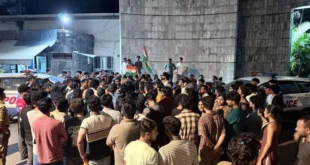06-12-2022
PORT-AU-PRINCE: In Port-au-Prince you cannot see the boundaries, but you must know where they are. Your life may depend on it. Competing gangs are carving up the Haitian capital, kidnapping, raping, and killing at will. They demarcate their territory in blood. Cross from one gang’s turf to another, and you may not make it back.
 Those who live here carry a mental map, dividing this teeming city into green, yellow, and red zones. Green means gang free, yellow can be safe today and deadly tomorrow, and red is a no-go area. The green area is shrinking as heavily armed gangs tighten their grip.
Those who live here carry a mental map, dividing this teeming city into green, yellow, and red zones. Green means gang free, yellow can be safe today and deadly tomorrow, and red is a no-go area. The green area is shrinking as heavily armed gangs tighten their grip.
Armed groups control and terrorize at least 60% of the capital and its surroundings, according to Haitian human rights groups. They encircle the city, controlling roads in and out and the UN says the gangs killed almost 1,000 people here between January and June of this year.
This report contains content which some readers may find upsetting, including sexual violence
Port-au-Prince is nestled between green hillsides and the blue waters of the Caribbean. It is blanketed by heat and neglect. The rubbish is knee-deep in places – a putrid monument to a crumbling state. There is no head of state (the last one was killed in office), no functioning parliament (gangs control the area around it) and the US-backed Prime Minister, Ariel Henry, is unelected and deeply unpopular.
 In effect the state is missing in action, as the people suffer overlapping crises. Almost half the population – 4.7 million Haitians – are facing acute hunger. In the capital around 20,000 people are facing famine-like conditions, according to the UN. This is a first for the Americas. Cholera has made a deadly comeback but armed gangs are the greatest plague.
In effect the state is missing in action, as the people suffer overlapping crises. Almost half the population – 4.7 million Haitians – are facing acute hunger. In the capital around 20,000 people are facing famine-like conditions, according to the UN. This is a first for the Americas. Cholera has made a deadly comeback but armed gangs are the greatest plague.
They set the clock here. Morning rush hour – between 06:00 and 09:00 – is peak kidnapping time. Many are snatched from the streets on their way to work. Others are targeted in the evening rush hour – from 15:00 to 18:00.
About 50 of the staff at our downtown hotel live in because it’s too dangerous for them to go home. Few here go out after dark. The manager says he never leaves the building.
Kidnapping is a growth industry. There were 1,107 reported cases between January and October of this year, according to the UN. For some gangs it’s a major income stream. Ransoms can run from $200 (£164) to $1m (£819,740), most victims come back alive, if the ransom is paid – but they are made to suffer.
 “Men are beaten and burned with materials like melted plastic,” says Gedeon Jean, of Haiti’s Centre for Analysis and Research in Human Rights. “Women and girls are subject to gang rape. This situation spurs relatives to find money to pay the ransom. Sometimes kidnappers call the relatives so they can hear the rape being carried out on the phone.”
“Men are beaten and burned with materials like melted plastic,” says Gedeon Jean, of Haiti’s Centre for Analysis and Research in Human Rights. “Women and girls are subject to gang rape. This situation spurs relatives to find money to pay the ransom. Sometimes kidnappers call the relatives so they can hear the rape being carried out on the phone.”
Morning in Delmas
We travel around by armored car. Normally that’s reserved for frontlines in warzones like Ukraine, but it’s necessary in Port-au-Prince to ward off kidnappers. It is a protection that many here can’t afford. It’s the poorest country in the Western hemisphere, prone to both natural and political disasters.
Kidnappers belong to competing gangs which are mainly grouped into two large coalitions, G9 and GPeP. (Int’l Monitoring Desk)
 Pressmediaofindia
Pressmediaofindia




